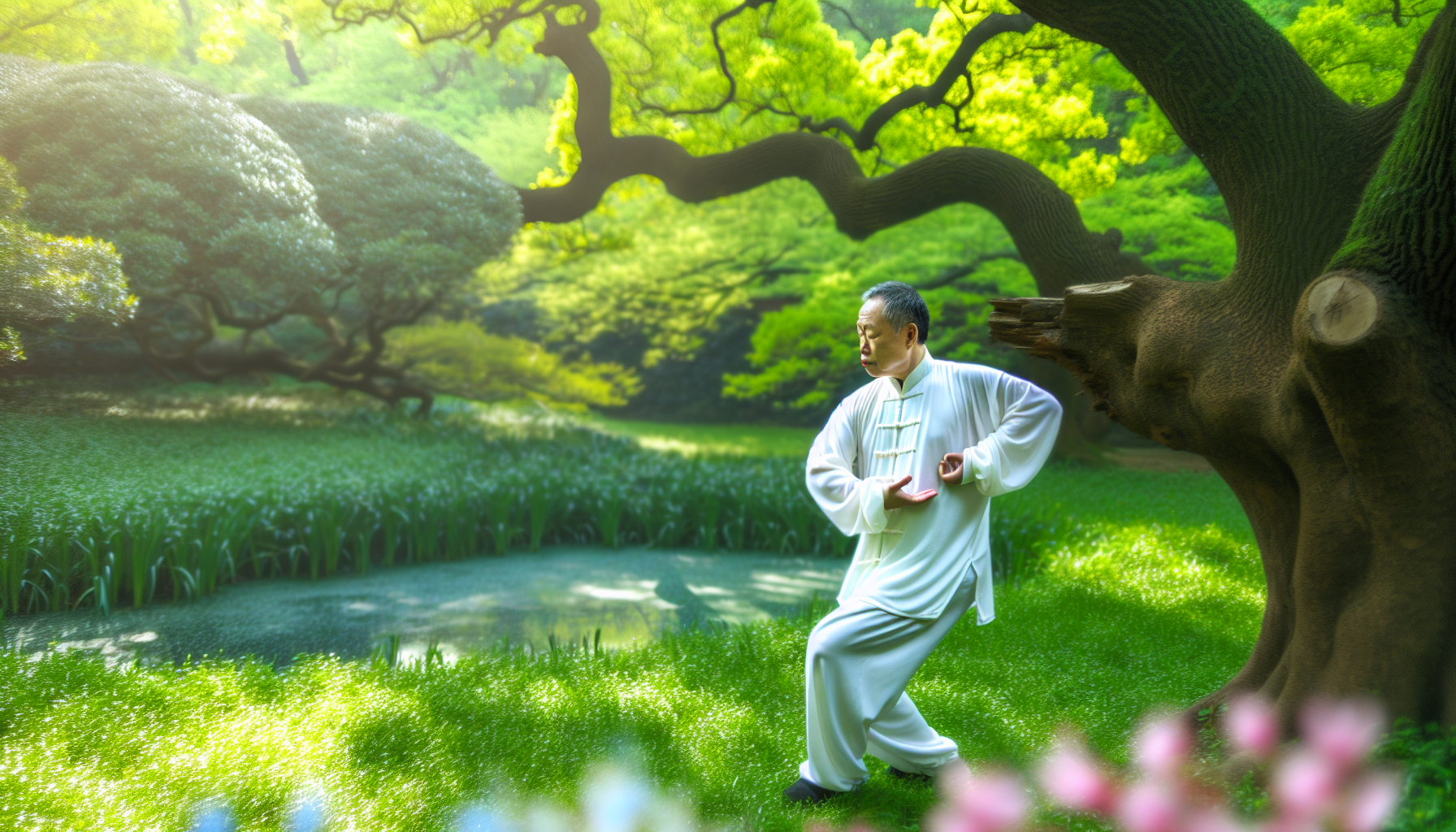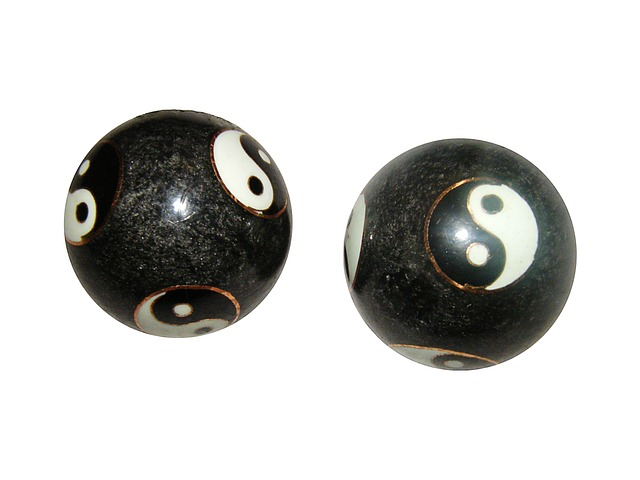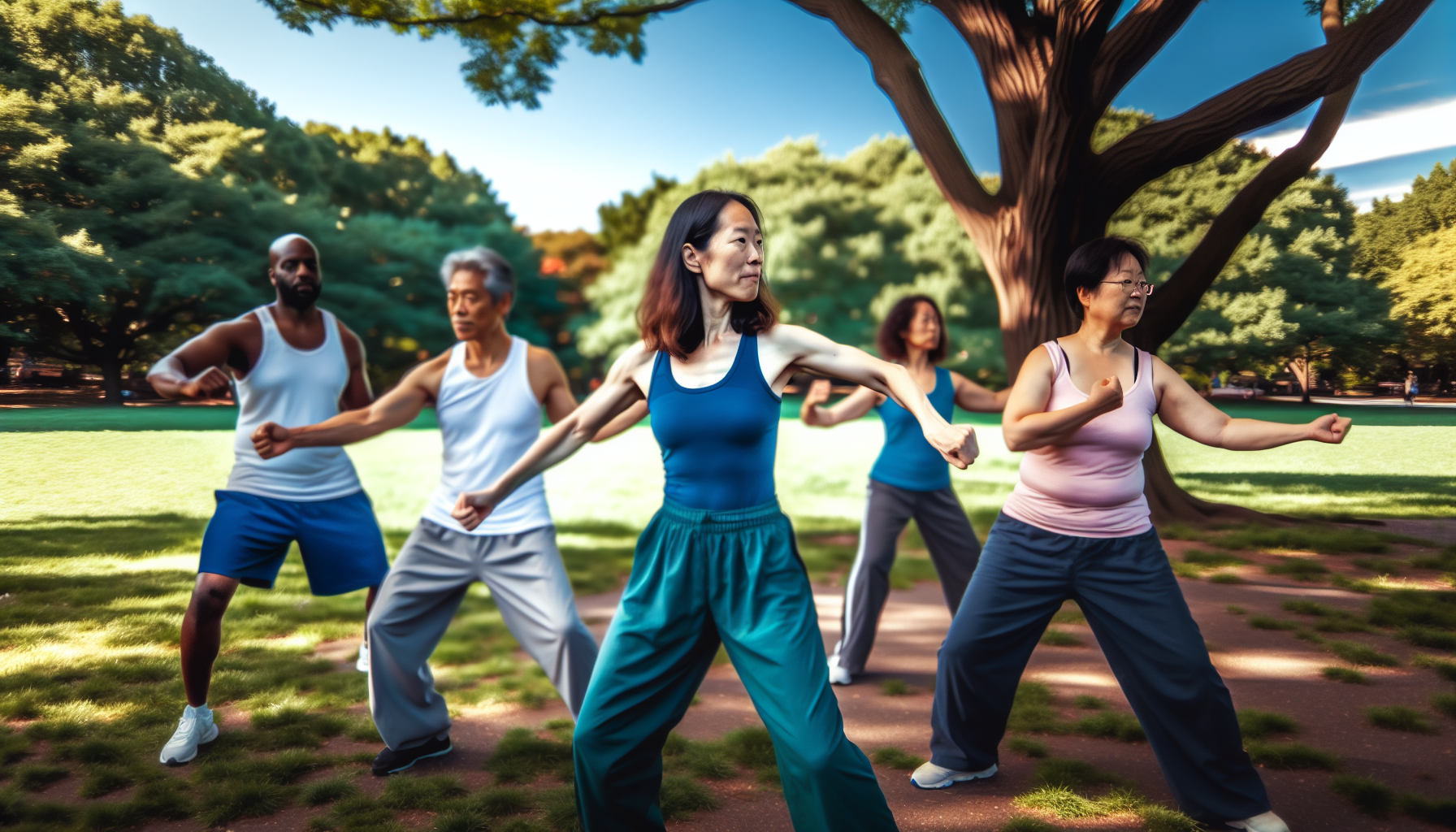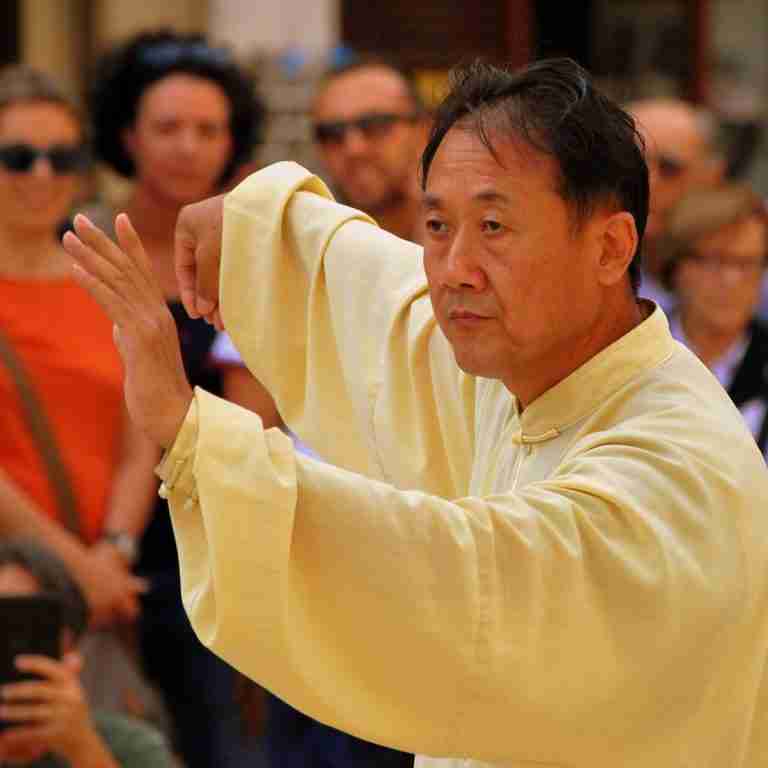Qigong vs Tai Chi: Exploring the Unique Benefits of Each Practice
Are you trying to decide between Qigong vs. Tai Chi? If you’re puzzled by the distinctions and benefits, you’re not alone. Both are time-honored Chinese practices that foster health and well-being through gentle movements, but they are not identical.
This article demystifies Qigong and Tai Chi, comparing the complexity, movements, and what outcomes you can expect from each. Whether you seek a holistic body workout or specific health improvements, continue reading to discover which practice aligns best with your personal goals!
Key Takeaways
- Tai Chi, originating from ancient Chinese martial arts, is a complex practice combining self-defense techniques and meditative movements to achieve mental stillness and improved physical health, particularly benefiting older adults through enhanced balance and chronic pain management.
- Qigong encompasses a range of simple, repetitive movements, grounded in Traditional Chinese Medicine, aiming to cultivate and balance life energy or Qi. It is notable for its accessibility to a wide range of fitness levels and targets specific organs and muscles for health improvement and disease prevention.
- When deciding between Qigong vs. Tai Chi, know that both practices foster physical health, mental clarity, and community connections. However, Tai Chi is more intricate, involving a sequence of movements that can be challenging to learn, while Qigong focuses on stationary poses and is generally more straightforward. Both can be adapted to individual needs and can complement each other when practiced together.
Defining Tai Chi: An Ancient Martial Art

Delving into the annals of history, Tai Chi finds its roots in the mystical Wudang Mountains of China. References to practices akin to Tai Chi date back to the T’ang Dynasty when recluses developed movement patterns in the solitude of the Chinese mountains.
The term Tai Chi, also known as Tai Ji, translates to ‘Supreme Ultimate Fist,’ an apt description for a practice that initially combined martial arts techniques for self-defense with exercises promoting longevity.
The Martial Roots of Tai Chi
The creation of Tai Chi is credited to Zhang Sanfeng, a Taoist from around the 14th century. Legend has it that Zhang was inspired by the combat between a snake and a bird, emphasizing the importance of yielding in martial encounters. Tai Chi’s emergence as a martial art is rooted in ancient Chinese martial arts, and it embodies a variety of techniques like:
- Kicking
- Hand striking
- Joint locking
- Wrestling
The self-defense techniques in Tai Chi borrow from the movements of animals such as tigers, eagles, cranes, and snakes, which have been passed down through generations.
Tai Chi as a Form of Moving Meditation
But Tai Chi is more than just a martial art. Over time, it has morphed into a form of moving meditation. It’s considered an “internal martial art” because it emphasizes relaxation ‘softness’ of the muscles. Like the flow of water, the slow and smooth control of movement in Tai Chi aims to achieve a state of serenity.
By coordinating controlled movements with deep, mindful breathing, practitioners of Tai Chi aim for mental stillness and heightened self-awareness, becoming relaxed and present.
The Health Benefits of Regular Tai Chi Practice
The transformative power of Tai Chi extends beyond the realms of the mind. Regular Tai Chi practice leads to tangible improvements in physical health, including increased strength, flexibility, and coordination, fostering overall physical wellness.
The benefits of Tai Chi are particularly pronounced for the elderly as it improves balance and reduces fall risks, promotes spinal health through proper posture and body alignment, and is beneficial for managing chronic pain conditions like arthritis.
Unveiling Qigong: Cultivating Life Energy

While Tai Chi has its unique charms, another ancient practice, Qigong (pronounced “chi gong”, offers a different path to wellness. Practicing Qigong, which focuses on cultivating and balancing life energy or Qi, is a cornerstone of health and well-being.
In fact, Qigong is often considered a complementary practice to Tai Chi, enhancing the benefits of both. Chi Kung, as it is also known, shares the same principles and goals as its counterparts, making it an essential part of the ancient practice.
The Qigong practice involves a blend of internal exercises for cultivating awareness and inner power, and external exercises to develop muscular strength and flexibility. Qigong’s repetitive movements stimulate various body functions, making it a potent tool for enhancing vital energy and vitality.
Qigong’s Role in Traditional Chinese Medicine

Deeply rooted in Traditional Chinese Medicine (TCM), Qigong exercises derive from ancient Chinese practices. The rationale behind Qigong practices is explained through TCM concepts such as:
- yin-yang
- the viscera and bowels
- qi, and blood
- meridians
- essential spirit theory
By enhancing qi and blood functions, smoothing the meridians, and balancing viscera, Qigong promotes health improvement and disease prevention.
The Simplicity and Power of Qigong Movements
Despite the depth of philosophy and principles behind it, Qigong is admired for its simplicity. The movements in Qigong are often repetitive and stationary, making them more accessible to people of various fitness levels.
Exercises such as the ‘Eight Pieces of Brocade’ are characterized by their simplicity and the integration of specific breathing patterns with gentle physical movements.
Boosting Vitality with Qigong Practices
Qigong is not just about simplicity; it’s about targeted focus. Qigong practices focus on specific organs and muscles, enhancing physical vitality.
For instance, Healing Sounds Qigong uses vocalizations to harmonize inner energy, while standing meditation improves balance and present-moment awareness, all contributing to mental and emotional balance.
Contrasting Qigong vs Tai Chi: Key Distinctions
While both Tai Chi and Qigong (paid link) share roots in ancient Chinese philosophy and aim to promote health and well-being, it’s essential to understand their key distinctions.
Tai Chi is generally considered more complex than Qigong, with a steeper learning curve. This complexity stems from Tai Chi’s focus on developing a sense of energy through the practice of detailed forms.
Comparing the Movement Styles
While Tai Chi involves fluid, dance-like sequences, Qigong consists of more stationary poses with repetitive movements. These Qigong movements are akin to targeted exercises, focusing on specific aspects of health, in contrast to Tai Chi’s full-body approach.
Qigong vs Tai Chi: Which Is More Challenging?
As far as complexity goes, Tai Chi tends to be more challenging to learn than Qigong. Tai Chi forms usually involve the memorization of a sequence of movements, which can be a challenging aspect for beginners.
Qigong involves simpler movements, which are often repeated instead of being strung together in a long sequence. This makes it less complex compared to other forms of exercise.
Intentions and Outcomes: What Are You Seeking?
When it comes to intentions and outcomes, Tai Chi and Qigong offer different pathways. Tai Chi focuses on developing a sense of energy through the practice of detailed forms, whereas Qigong focuses on the feeling of energy with each motion. Thus, choosing between Tai Chi and Qigong largely depends on what you’re seeking – a comprehensive body workout or targeted relief for specific health needs.
Incorporating Tai Chi and Qigong into Your Lifestyle

Now that we’ve explored the nuances of Qigong vs Tai Chi, let’s delve into how these practices can become a part of your everyday life.
Whether you’re a morning person who likes to start the day with a burst of energy or an evening person who prefers winding down with gentle movements, Tai Chi and Qigong can easily be incorporated into your daily routine.
Finding the Instructor
Finding the right tai chi or qi gong instructor or class is paramount to your Tai Chi or Qigong journey. An experienced Qigong instructor can guide you through the practices, ensuring you perform each movement with proper technique. Attending trial lessons or workshops with various tai chi classes can help you make an informed decision.
Qigong vs Tai Chi: Is it Possible to Blend Both Practices?
For those who are intrigued by both Tai Chi and Qigong, you might be wondering if it’s possible to blend both practices. Indeed, it is possible to practice both simultaneously.
The key lies in understanding how each practice complements the other, enhancing concentration and deep breathing and maximizing benefits from the movements.
Adapting Practices for Different Needs
Regardless of your physical abilities or health conditions, Tai Chi and Qigong can be adapted to suit your needs. Tai Chi’s low-impact, gentle movements are safe for individuals of all ages, allowing adaptations for those with physical limitations or conditions.
Similarly, Qigong’s exercises can be specially chosen to cater to various physical issues, making it highly adaptable to individual needs.
From Practice to Lifestyle: The Transformative Effects of Tai Chi and Qigong
Beyond the physical movements and meditative aspects, Tai Chi and Qigong can have transformative effects on your lifestyle. They enhance physical health, cultivate mental clarity, and foster community connections.
Enhancing Physical Health and Wellness

Both Tai Chi and Qigong have been found to provide a wide range of physical health benefits. These include:
- Improved flexibility
- Balance
- Overall strength
- Improved coordination
- Increased fitness
- Relief from chronic pain
These are just some of the physical health benefits reported by practitioners. For those recovering from illness, such as cancer, Tai Chi and Qigong practices offer a means to manage their symptoms and enhance their overall well-being.
Cultivating Mental Clarity and Emotional Balance

Beyond physical wellness, Tai Chi and Qigong promote mental clarity and emotional balance. They lead to physiological changes in the brain, such as:
- Increased activity in areas associated with mindfulness
- Increased activity in areas associated with attention
- Increased activity in areas associated with emotion regulation
Qigong also enhances spirituality, offering a greater sense of purpose and meaning in life, alongside cultivating compassion and gratitude.
Fostering Community and Connection
Practicing in group settings fosters a sense of community and social support in both Tai Chi and Qigong, enhancing overall well-being and engagement in life. Tai Chi is often practiced in group settings, which can enhance health benefits and adherence to the practice.
The social networks of individuals, especially older adults who may face social isolation, are broadened through Tai Chi, improving self-efficacy for exercise and engagement with life.
Qigong vs Tai Chi is Not a Competition
As we’ve journeyed through the realms of Tai Chi and Qigong, it’s clear that these ancient practices offer more than just physical benefits. They enhance mental clarity, foster community connections, and can be adapted to individual needs.
Whether you’re seeking a comprehensive body workout with Tai Chi or targeted relief for specific health needs with Qigong, these practices hold the potential to transform your lifestyle.
Have you ever tried Tai Chi or QiGong?
Or are you a regular practitioner?
How have these ancient practices helped you in your modern life?
Please let us know in the comment section!
Frequently Asked Questions
What is the primary difference between Qigong vs Tai Chi?
The primary difference between Tai Chi and Qigong is that Tai Chi is considered more complex, focusing on key movements. Qigong is more simplistic and focuses on the feeling of energy with each motion.
Can I practice both Tai Chi and Qigong?
Yes, you can practice both Tai Chi and Qigong simultaneously to enhance concentration, deep breathing, and maximize the benefits from the movements.
How can I incorporate Tai Chi and Qigong into my daily routine?
Start by incorporating small daily increments of Tai Chi and Qigong into your routine to build a consistent habit. Consider creating a dedicated practice space at home and using online resources for guided practice.
Can Tai Chi and Qigong be adapted for those with physical limitations or conditions?
Yes, Tai Chi and Qigong can be adapted to accommodate physical limitations or conditions. Both can offer safe and gentle movements for individuals of all ages.
What are the benefits of practicing Qigong vs Tai Chi in group settings?
Practicing Tai Chi and Qigong in group settings fosters a sense of community, social support, and enhances well-being. This connection with others can contribute to a more engaged life.








